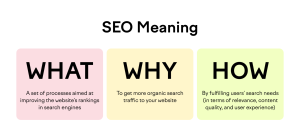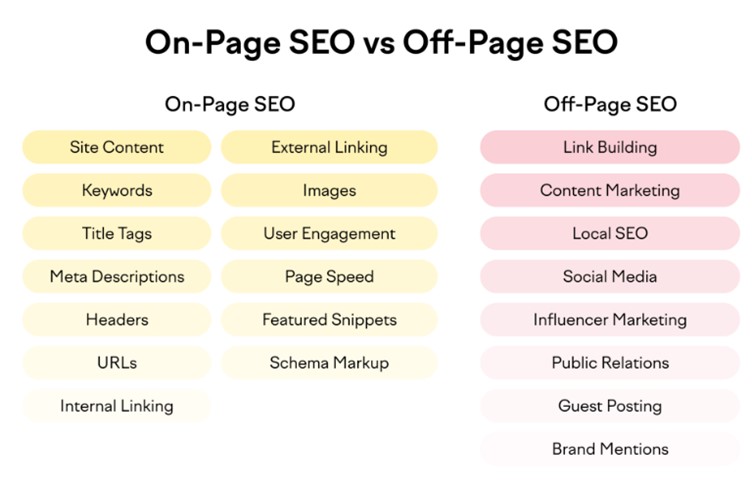SEO : Search Engine Optimization

For most of us today, When we need something, whether it’s an answer to a question, a query, a service, or an idea —we start by asking search engines like Google, Yahoo, Bing, etc.
Google alone generates 3.5 billion searches per day. Search engines have become integral to our lives, with the increase in access to the internet and disposal of information on our smartphones .We require an approach towards an enhanced user experience which is being accelerated by SEO (Search Engine Optimizations).
Understanding How Search Engines Work
Understanding the technical processes behind how the search engine works is necessary to comprehend SEO as a concept and strategy. Search engines have a single goal ,their aim is to give users the most relevant answers to our queries.
When talking about traditional web search engines like Google, there are four separate stages of the search
Crawling: Search engines use crawlers to discover pages on the web by following links and using sitemaps. Gathering, Categorizing, and Storing them in its index.
Rendering: Web Browsers generate how the page will look using HTML, JavaScript and CSS information.
Indexing: Web crawler analyze the content and metadata of the pages it has discovered and add them to a database
Ranking: Complex algorithms look at a variety of signals to determine whether a page is relevant and of high enough quality to show when searchers enter a query.
Overview of Search Engine Ranking Algorithm
The search engine ranking algorithm is composed of 200+ ranking factors that are considered the major ranking factors. However, there are several other new factors that are added every day. Yes, you read that right, every day. This is the reason organic rankings of a website keeps on fluctuating.
The most important ranking factors are:
- User experience: Google loves to rank sites higher up in the search results that offer a great user experience. Faster site speed, easy navigation, unnecessary pop-ups, no spam content, are all factors that contribute to good user experience.
- Links: As previously mentioned, links are the most significant ranking factor among all the factors that Google uses in its ranking algorithm. Links are counted as a vote to your site, the more votes your site has, the higher it will rank in the search results.
- Technical SEO: Before ranking your site, Google and other search engines must index and understand its content.
- Content: The search engines determine the ranking of any site based on its quality content. If the content on your site is unique that no other web page has on a particular topic, then Google will consider this and rank it higher in the search results. Your content should help the reader and should be the best content on the entire web on the topic.
SEO as a Concept and its Types

SEO as a Concept and Tool
The term SEO, Search Engine Optimization, refers to improving your site’s visibility in Search engines like Google, Yahoo, Bing etc. with the goal of getting more organic traffic.
Essentially, SEO is about fulfilling users search needs by creating relevant, high-quality content and providing the best possible user experience.
SEO as a Marketing Strategy
An SEO marketing strategy is a comprehensive plan to increase organic traffic to your website through search engines. By Optimizing the elements of on-site and off-site SEO like Keywords, Meta Description, Title Tags, Internal Links, Backlinks, Local SEO and more.

Types of SEO
There are three types of SEO:
On-site SEO also called as On-Page SEO refers to the practice of optimizing elements on a website, such as the content and HTML code, to improve it’s rankings in search engine results pages and attract more relevant traffic to the website.
Off-site SEO also know as Off-Page SEO, is the practice of improving a website’s search engine ranking by optimizing factors outside of the website. This can be done by building high-quality backlinks, promoting the website on social media, and other forms of online marketing.
The goal is to increase the website’s authority, reputation, and relevance in the eyes of search engines, which can result in higher search engine rankings and more organic traffic to the website.
Technical SEO involves making website optimizations that help search engines crawl and index a website more precisely, thereby improving its search engine ranking. This includes tasks such as optimizing site load time, ensuring that robot.txt files are properly configured, and setting up redirects correctly.
How to do SEO: On-page optimization
How to optimize your website so you can rank higher on SERP’s and get more traffic. This requires a comprehensive approach to optimize the elements of on-page, off-page and technical SEO.
Here are your on-page optimization steps:
1. Keywords
Identifying the keywords you’re optimizing for is the first step in search engine optimization. These are terms that your ideal website visitors are likely to type into Google or other search engines.
Keyword Research
- Create your seed list: Start by listing out the words and phrases your ideal customers are typing into Google. Think about their interests, desires, pain points, and goals, and think in terms of the language and intent
- Plug them into a keyword research tool: Keyword research tools will give you data around these keywords so you can see which terms you can conceivably rank for and where the best opportunities actually lie.
- Sort and prioritize: Targeting keywords with a high search volume is ideal for achieving decent reach, but not so high that it becomes too competitive to rank for. Better to show up on page one for a lower volume, lower competition keyword than to not rank at all for a high volume, high competition keyword.
Placing your keywords
In addition to placing your keywords naturally in the body of your content, you’ll want to place your keyword into specific spots on the page to indicate to Google what you’re looking to rank for.
This includes:
- SEO title (title tag)
- Page title (H1 tag)
- At least two H2 headings
- Image alt text
- Image file name
- Naturally in the body
2. Title Tag and Header Tags (HTML Tags ); H1 Tag , H2 and H3 Tag :
A title tag is what’s going to show up in the browser tab and (most likely) the search engine results pages (SERPs) it is the single most impactful place you can put your keyword.
To optimize your titles, be sure to:
- Include the keyword
- Have only one H1 per page
- Keep title tags to 55-60 characters.
- Indicate value
- Don’t be repetitive or stuff keywords.
- Try long sentences (long tail keywords)
- Be specific
- Align your keywords with a searcher’s intent
3.URL
A URL (Uniform Resource Locator) is the web address of an internet resource, like a webpage. When we refer to its structure it is generally the fragments of the URL structure namely Protocol, Subdomain, Domain, TLD, Slug
- Include your primary keywords
- Use secure protocol for Data Protection https:// (“s” stands for secure)
- Go for a domain name that suits your business profile and web page content
- Filter parameters for sort and filter listings on category pages.
4. Meta Descriptions
In HTML, a meta description is a short snippet that summarizes the content of a web page. On a search engine results page (SERP), the meta description appears under the page title and URL.
To optimize your meta description:
- Include the keyword and related keywords if you can do so in a natural and compelling way,
- Keep it short: Ideal meta description length is 155-165 characters.
- Make it compelling: Remember, showing up in search results is just the first step! You still need to get searchers to click. Include a concise description, a clear benefit, and a call to action, like ad copy!
In the preparation for this post, I’ve researched some good meta description examples, and the reason why they’re good for SEO.

Why? This meta description is written for the end user. It’s informative and communicates an idea of enjoyment and community while being brief.
Uber

Why? A great example of priority, it’s straight to the point, plus it provides a solution to a problem
5. Image Optimization
SEO optimization relies heavily on images. They keep users engaged with your pages, enhance the quality of the information, and provide opportunities for you to rank and generate traffic to their host pages through image results. Plus, Google has increasingly been making the SERP more visual.
Here’s how to do SEO optimization for images:
- Customize File name: Save the file name with the keyword, with dashes instead of spaces.
- Choose the right format: PNG, JPEG
- Beware of copyright
- Compress: Large images can slow down the speed of your site. Compress them to reduce file size and properly size them. You shouldn’t need images much wider than 1000px, but every site is different
- Add alt text: Alt text stands for the text alternative of an image, and it’s how Google “sees” an image on a page and detects its relevance to the keyword. It also makes your site accessible for screen readers, and if images break, the alt text will still appear.
6.Internal and External Links
External links: Find 1-3 pages relevant to the topic you’re targeting, on other sites that have high domain authority, and link to them in your post. This helps to build trust with Google.
Internal links: Link to other blog posts on your site in the content of the post you’re writing—just like I did in that last bullet, using “high domain authority” as my anchor text. This gives Google multiple pathways to any given post, making your site easier to crawl as a whole.
How to do SEO: Off-page optimization
Off-page SEO, on the other hand, is what you do on other pages of your website, other websites, and even other platforms to help your page to rank. Here are some off-page SEO tactics
Backlinks
Backlinks, which are links to your site from other websites, are the third most important factor in Google ranking. The more high-quality backlinks you have, the higher you’ll rank. In general backlinks are an effective way for building Brand Representation and creating Social media presence stirring up the wheel for SEO.
Link quality factors :
- The popularity of linking site
- Topic Relevance
- Domain Authority
Link Building : we refer the process of acquiring new Backlink as link building which requires a vigilant and strategic approach towards itself
“Here are some strategies to do it:
- Directory Submission: You find niche and local directories that can list your website.
- Guest Posting: One of the best methods of link building is guest posting. Under guest posting, you find webmasters looking for contributors to write articles on their website. You apply, become a contributor, and publish an article with a link back to your own site either in the author’s bio or in the content body.
- Forum Posting: You register on a niche forum site and become a regular contributor. You get a link either from the signature of your profile or from the answers that you write.
- Q&A Posting: Similar to Q&A posting, you register on a niche Q&A site and become a contributor. You gain a link from the answers that you write to help the users.
- Press Release: These are brand advertisements that specifically talk about your business and gives a backlink to your site.
- Content Marketing: One of the most white-hat friendly ways of getting a backlink is via content marketing. Under content marketing, you prepare content and post them on your website. People link back to it naturally because they like your content and gain value from it.
- Acquiring brand mentions and citations for a website on social media platforms, forums, or QA platforms.
- Influencer marketing activities to improve the overall branding of the business (or the domain).
- Generating positive reviews and recommendations.
- Acquiring comments to a blog post.
How to do SEO: Technical optimizations
Technical SEO optimizations are done on the back end of your website to make sure it meets Google’s site security and user experience requirements, as well as to make it as easy as possible for Google to do its job on your site.
Here are some of the main technical optimizations to take care of:
- Create SEO friendly URLs that are easy to read and understand.
- Have easy navigation on the site such that every link is no longer than three clicks away.
- The speed of the site should be good. You can check it with the help of Google Page Speed Insights.
- Check and fix any broken links on the site using tools like Screaming Frog SEO Spider.
- Optimize the meta tags, title tags, and heading tags.
- Optimize the images and content on the site.
- Add Nofollow tag to outbound links that are user-generated and not editorially added.
- Inclusion of your target keyword in the title, URL, heading, and first paragraph of the content.
- Optimize the internal linking of the site so that all the important pages receive the maximum link value.
- Identify and fix issues on the site as suggested by the Google Search Console and Google Analytics.
- Add proper rich snippets and metadata to the site so that the search engines are able to understand your site content.
- Set up proper goals in Google Analytics so that all the KPIs are tracked regularly.
- Canonical URLs: A canonical URL is the URL that you want to represent a set of duplicate pages. Google will do its best to identify the canonical URL for any given set of duplicates, but you can also indicate this to Google through canonical tags. Thus Check and fix any unnecessary redirects
- Crawlability/indexability: Your sitemap and robots.txt together tell Google what you do and don’t want Google to crawl and index.
- Schema markup: Schema markup helps Google (and other search engines) understand the types of content you have, allowing it to display rich results when applicable. For example, sitelink schema can give you more real estate on the SERP:
Local SEO
Local SEO aids businesses in reaching their local audience by analyzing their behavior through trillions of searches. If you use local SEO practices, then your local business has the opportunity to rank higher in the search results and the local map pack at the same time. This, in turn, helps grow your business and increase traffic to your website.
Local SEO Search Ranking Factors
- Proximity to a searcher’s location “With the rise of local searches containing the phrase, “near me,”
- “Keywords are essential for local SEO too
- NAP: Name, Address, Phone no. as in of Google Business Profile
- Reviews and citations in reference to a business address or name
How to Monitor & Track SEO Results
Technical setup, content, and links are critical to getting a website into the search results. Monitoring your efforts helps improve your strategy further. Measuring SEO success means tracking data about traffic, engagement, and links.
SEO KPI’s (key performance indicators),are one of the way to measure the success of SEO which provides with a comprehensive outlook .
Here are the most common ones:
- Organic traffic growth
- Keyword rankings (split into branded and non-branded terms
- Conversions from organic traffic
- Average time on page and the bounce rate
- Top landing pages attracting organic traffic
- Number of indexed pages
- Links growth (including new and lost links)





